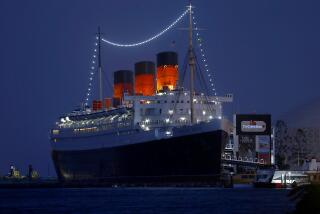Transatlantic Cruise Market Remains Tiny, Not Titanic
- Share via
“Titanic,” the biggest-grossing movie in history, has countless Americans day-dreaming about the romance of an old-fashioned cruise. The cruise industry, riding a global boom, is building new ships as fast as it can. And the Atlantic, the planet’s second-largest ocean, certainly has plenty of room. So the transatlantic cruise business is booming, right?
Wrong. That great ocean remains, in a sense, the world’s smallest cruise market.
It sustains only a single ship with regularly scheduled transatlantic crossings: Cunard’s famed Queen Elizabeth 2, age 31, capacity 1,715 passengers--and the QE2 spends less than one-third of its time on that itinerary.
Every year, many ships carry passengers across the ocean as they reposition themselves between winters in the Caribbean and summers in the Mediterranean, but on the day--whenever it comes--when QE2 stops regular transatlantic service, experts say, a chapter in travel history will close. With its broad decks and clubby interiors, the QE2 is one of the cruise industry’s last links with the old-fashioned luxury, the romanticism and the class system symbolized by the Titanic.
But icebergs are not a factor here. Technology, demographics and corporate consolidations are.
First, in the late 1950s, came the advent of daily passenger jet service between the U.S. and Europe, which quickly stole away most cruise ship customers. In the early 1970s came the rise of Carnival Cruise Lines, which reinvented the industry by selling cruises to the masses and, once you were outside of your cabin, making virtually no class distinctions.
Then on April 3 the old and new worlds of cruising met. The relative upstart Carnival Corp. announced it (with some Norwegian minority partners) was buying venerated Cunard from its Norwegian parent company for $500 million. Carnival officials said they would merge Cunard with Seabourn Cruise Line (50% owned by Carnival) to form the world’s largest luxury line.
A Carnival spokesman said he expected no immediate changes in the QE2’s schedule, which calls for crossing the Atlantic 17 times this year on six-day routes between New York and Southhampton, England, but the owners aren’t saying much more.
Cunard officials aren’t saying much, either, except to note that thanks to the ship’s thick hull, it has “many, many good years of sailing left.”
But the Carnival purchase, along with the brisk sales for the QE2 around-the-world cruise that concludes next month, leads Cruise Week newsletter editor Mike Driscoll to ponder “a question mark in the QE2’s future. You have to wonder if they might be thinking of [forsaking transatlantic passages for] longer itineraries.” And with Carnival’s wealth and willingness to build new ships, Driscoll points out, there is now “the possibility that there might be a QE3 somewhere down the line.”
For now, however, the QE2 endures in a sort of twilight zone, clinging to its traditional route for about 100 days a year (it sails other itineraries the rest of the time) while newer ships jostle each other in the Caribbean, the Pacific coast of Mexico, Alaska and the Mediterranean.
Aside from its point-to-point service, the QE2 is set apart by its “cabin grades” system, which directs passengers to specific dining rooms based on what they’ve paid for their cabins. Only passengers in the priciest cabins can dine in the Queens Grill and drink in the Queens Grill Lounge. At the next level are those in the Princess and Britannia grill restaurants, then those in the Caronia restaurant, and finally those in the Mauretania restaurant, who, unlike their fellow passengers, are assigned to either early or late seatings. Ties and jackets are expected on men in all dining rooms each night, and on the three formal nights of a standard crossing, black tie or dark business suits are requested. (For those who rebel, the ship does offer a casual cafe open to all.)
This year’s first transatlantic cruise leaves Southhampton on Wednesday. The last arrives in New York Dec. 20. Twelve have themes--British theater; food and wine; and Atlantic cruise liner history, for instance. Fares begin at about $400 per person per day (including one-way coach air fare across the Atlantic).
“One of the things on everybody’s list [of dream trips] is crossing the Atlantic on the QE2. It just isn’t the same crossing on anything else. . . . And I hope that that doesn’t go away,” says Matthew Upchurch, a veteran of “nine or 10” QE2 crossings.
Upchurch is managing principal of Fort Worth-based API Travel Consultants, a consortium of about 200 luxury travel agencies nationwide, and a major deliverer of customers to Cunard. Upchurch speculates that the QE2 could easily sail for another two decades.
“She is the only North Atlantic express liner left--what Cunard started, Cunard will finish,” wrote author John Maxtone-Graham of the QE2 in a 1989 volume on Cunard’s history.
The QE2, christened by Queen Elizabeth II herself in 1967, carried British troops to the Falklands War in 1982, and in 1987 switched from a steam turbine engine to diesel-electric power. In 1994, a $45-million upgrade went awry when post-renovation passengers boarded to find faulty plumbing and tradesmen still at work. But in the fall of 1996, after Cunard’s parent company was bought out by the Norwegian conglomerate Kvaerner ASA, the ship got a crucial vote of confidence: an $18-million upgrade that brought it into compliance with recently stiffened maritime Safety of Life at Sea (SOLAS) codes.
Reynolds travels anonymously at the newspaper’s expense, accepting no special discounts or subsidized trips. He welcomes comments and suggestions, but cannot respond individually to letters and calls. Write Travel Insider, Los Angeles Times, Times Mirror Square, Los Angeles 90053 or e-mail chris.reynolds@latimes.com.
More to Read
Sign up for The Wild
We’ll help you find the best places to hike, bike and run, as well as the perfect silent spots for meditation and yoga.
You may occasionally receive promotional content from the Los Angeles Times.







